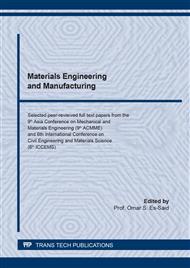[1]
M.K. Suzette, Department of the Interior USGS. In Mineral Commodity Summaries 2009; Government Printing Oce: Washington, WA, USA, (2009).
Google Scholar
[2]
H. Klee, The cement sustainability initiative: recycling concrete. World Business Council for Sustainable Development (WBCSD): Geneva, Switzerland (2009).
Google Scholar
[3]
A. Hasanbeigi, L. Price, E. Lin, Emerging energy-efficiency and CO2 emission-reduction technologies for cement and concrete production: a technical review. Renew Sust Energ Rev 16.8 (2012): 6220-6238.
DOI: 10.1016/j.rser.2012.07.019
Google Scholar
[4]
Z. Zhang, JL. Provis, A. Reid, H. Wang, Geopolymer foam concrete: an emerging material for sustainable construction. Constar Build Mater 56 (2014): 113-127.
DOI: 10.1016/j.conbuildmat.2014.01.081
Google Scholar
[5]
X. D. Zhang, & Y.Han, Thermal insulation properties of fly ash and waste polystyrene mixed block building materials. Chemical Engineering Transactions, 55 (2016): 253-258.
Google Scholar
[6]
F.Asdrubali, F. D'Alessandro, S. Schiavoni, A review of unconventional sustainable building insulation materials. Sustainable Materials and Technologies, 4 (2015): 1-17.
DOI: 10.1016/j.susmat.2015.05.002
Google Scholar
[7]
A. A.Sabtan, & W. M. Shehata, Evaluation of engineering properties of scoria in central Harrat Rahat, Saudi Arabia. Bulletin of Engineering Geology and the Environment, 59.3 (2000): 219-225.
DOI: 10.1007/s100640000061
Google Scholar
[8]
L. Boukhattem, M. Boumhaout, H. Hamdi, B. Benhamou, & F. A. Nouh, Moisture content influence on the thermal conductivity of insulating building materials made from date palm fibers mesh. Construction and Building Materials, 148 (2017): 811-823.
DOI: 10.1016/j.conbuildmat.2017.05.020
Google Scholar
[9]
M.R. Moufti, A.A. Sabtan, O.R. El-Mahdy, W.M. Shehata, Assessment of the industrial utilization of scoria materials in central Harrat Rahat, Saudi Arabia. Engineering Geology 57.3-4 (2000): 155-162.
DOI: 10.1016/s0013-7952(00)00024-7
Google Scholar
[10]
M.R. Moufti, K. Németh, Harrat Rahat: The Geoheritage Value of the Youngest Long-Lived Volcanic Field in the Kingdom of Saudi Arabia. In: Geoheritage of Volcanic Harrats in Saudi Arabia. Springer (2016): 33-120.
DOI: 10.1007/978-3-319-33015-0_3
Google Scholar
[11]
S. Alraddadi, A. Saeed, & H. Assaedi, Effect of thermal treatment on the structural, electrical, and dielectric properties of volcanic scoria. J Mater Sci: Mater Electron 31 (2020): 11688-11699.
DOI: 10.1007/s10854-020-03720-0
Google Scholar
[12]
A. Husain, K. Kupwade-Patil, AF. Al-Aibani, MF. Abdulsalam in situ electrochemical impedance characterization of cement paste with volcanic ash to examine early stage of hydration. Constr Build Mater 133 (2017): 107-117.
DOI: 10.1016/j.conbuildmat.2016.12.054
Google Scholar
[13]
AR. Dwyer, & SP. Dwyer, Washington, DC: U.S. Patent and Trademark Office, U.S. Patent No. 10,115,530. (2018).
Google Scholar
[14]
L.N. Tchadjie, S.O. Ekolu, Enhancing the reactivity of aluminosilicate materials toward geopolymer synthesis. J Mater Sci 53.7 (2018): 4709-4733.
DOI: 10.1007/s10853-017-1907-7
Google Scholar
[15]
M.F. Serra, M.S. Conconi, G. Suarez, E.F. Aglietti, N.M. Rendtorff, Volcanic ash as flux in clay based triaxial ceramic materials, effect of the firing temperature in phases and mechanical properties. Ceram Int 41.5 (2015): 6169-6177.
DOI: 10.1016/j.ceramint.2014.12.123
Google Scholar
[16]
C. Leonelli, E. Kamseu, D.N. Boccaccini, U.C. Melo, A. Rizzuti, N. Billong, P. Miselli Volcanic ash as alternative raw materials for traditional vitrified ceramic products. Adv Appl Ceram 106.3 (2007): 135-141.
DOI: 10.1179/174367607x159329
Google Scholar
[17]
K. Kupwade-Patil, A.F. Al-Aibani, M.F. Abdulsalam, C. Mao, A. Bumajdad, S.D. Palkovic, O. Büyüköztürk, Microstructure of cement paste with natural pozzolanic volcanic ash and Portland cement at different stages of curing. Constr Build Mater 113 (2016): 423-441.
DOI: 10.1016/j.conbuildmat.2016.03.084
Google Scholar
[18]
K. Kupwade-Patil, S Chin, J. Ilavsky, R.N. Andrews, A. Bumajdad, O. Büyüköztürk, Hydration kinetics and morphology of cement pastes with pozzolanic volcanic ash studied via synchrotron-based techniques. J Mater Sci 53.3 (2018): 1743-1757.
DOI: 10.1007/s10853-017-1659-4
Google Scholar
[19]
Patric Lemougna, Kai-tuo Wang, Qing Tang, A.N. Nzeukou, N. Billong, U. Chinje Melo, Cui Xue-min Review on the use of volcanic ashes for engineering applications. Resour Conserv Recycl 137 (2018): 177-190.
DOI: 10.1016/j.resconrec.2018.05.031
Google Scholar
[20]
S.Alraddadi, Surface and thermal properties of fine black and white volcanic ash. Materials Today: Proceedings, 26 (2020): 1964-1966.
DOI: 10.1016/j.matpr.2020.02.429
Google Scholar
[21]
C.Buratti, , E.Moretti, , E.Belloni, , & F.Agosti, Thermal and acoustic performance evaluation of new basalt fiber insulation panels for buildings. Energy Procedia, 78 (2015): 303-308.
DOI: 10.1016/j.egypro.2015.11.648
Google Scholar
[22]
S. Alraddadi, Effects of calcination on structural properties and surface morphology of black volcanic ash. Journal of Physics Communications, 4.10 (2020): 105002.
DOI: 10.1088/2399-6528/abbcdc
Google Scholar
[23]
S.Alraddadi, , & H. Assaedi, Characterization and potential applications of different powder volcanic ash. Journal of King Saud University-Science, 32.7 (2020): 2969-2975.
DOI: 10.1016/j.jksus.2020.07.019
Google Scholar
[24]
G. Fares, A. Alhozaimy, O. A. Alawad, & A. Al-Negheimish, Evaluation of powdered scoria rocks from various volcanic lava fields as cementitious material. J of Mater in Civil Eng 28.3 (2016): 04015139.
DOI: 10.1061/(asce)mt.1943-5533.0001428
Google Scholar
[25]
P. Zhang, J. Huang, Z. Shen, X. Wang, F. Luo, P. Zhang, J. Wang, S. Miao, fired hollow clay bricks manufactured from black cotton soils and natural pozzolans in Kenya. Constr and Build Mater 141 (2017): 435-441.
DOI: 10.1016/j.conbuildmat.2017.03.018
Google Scholar
[26]
C. Leonelli, E. Kamseu, D.N. Boccaccini, U. C. Melo, A. Rizzuti, N. Billong, & P. Miselli, Volcanic ash as alternative raw materials for traditional vitrified ceramic products. Adv appl ceram 106(3) (2007):135-141.
DOI: 10.1179/174367607x159329
Google Scholar
[27]
R. L. Bates, Geology of the industrial rocks and minerals (1960).
Google Scholar
[28]
S. J. Lefond, Industrial rocks and minerals (1975).
Google Scholar
[29]
F. I. de la Precontrainte, FIP manual of lightweight aggregate concrete. Surrey University Press (1983).
Google Scholar


